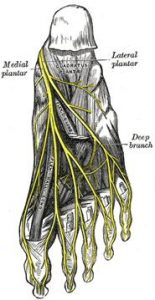Morton’s neuroma is a little-known but all-too-common ailment that causes you to feel as if you have a pebble in your shoe. It might cause lifelong nerve damage and other issues if left untreated. Custom orthotics, in combination with other treatments, can help alleviate the pain and difficulties associated with Morton’s Neuroma. This article will look at how they can assist.
Morton’s Neuroma Causes and Symptoms
When the tissue surrounding the nerves leading to your toes grows, Morton’s neuroma develops. When a person wears high-heeled or tight shoes that compress the toes, these tissues appear to thicken.
Participation in high-impact activities that involve repetitive trauma and stress on your feet appear to be another cause of Morton’s neuroma. Rock climbing and snow skiing are examples of these activities.
Morton’s neuroma appears to be more common in those with pre-existing foot abnormalities. Bunions, hammertoes, high arches, and flat feet are all risk factors for developing the disorder.
Morton’s neuroma doesn’t have a lot of symptoms, but the ones it does have are prominent and visible.
Morton’s Neuroma Symptoms
Feeling like you’re walking on a stone in your shoe
A burning sensation in the ball of your foot that spreads to your toes
A tingling or numb sensation in your toes
Morton’s neuroma can be identified by any one or a combination of these symptoms, especially if they are persistent.
If you tell your doctor about your symptoms, he or she will most likely order one of the tests listed below.
Physical Exam – Your doctor will press down on your foot to feel for a lump. This could be painful or cause a “clicking” sensation between your toes.
X-rays – Your doctor may conduct x-rays to rule out other ailments including stress fractures, which can produce comparable pain and discomfort to Morton’s neuroma.
Ultrasound imaging is a type of imaging that employs sound waves to assist clinicians in generating images of physiological structures. They can assist clinicians in detecting irregularities in soft tissue, such as those seen in Morton’s neuroma.
Magnetic resource imaging (MRI) is a type of diagnostic imaging that uses magnetic fields to find tissue abnormalities and can be useful in determining the presence of Morton’s neuroma.
An ultrasound, in conjunction to a physical examination, is likely to be the most useful imaging. They are the least expensive of the three diagnostic imaging options and are excellent at detecting tissue damage.
X-rays can detect bone and joint fractures, but not soft tissue injuries such as Morton’s neuroma. MRIs can be beneficial, but they’re expensive and can sometimes produce false positives or negatives (showing neuromas that aren’t there or failing to identify neuromas that are).

What Orthotics Can Do for You
Morton’s neuroma is fortunately a relatively curable illness, especially if caught early. Without a doubt, the first line of treatment will be non-invasive and conservative. It’ll most likely start with orthotic footwear and solutions.
Wearing shoes with plenty of room is your best bet in terms of footwear. Shoes with deep and broad toe boxes are great because they give the foot enough room. Custom orthotics can also be easily inserted into these types of shoes. Shoes with a lot of padding are also useful since they reduce pressure on already stressed toes.
Custom insoles, in terms of orthotics, can assist relieve pressure on toes, allowing them to heal. Insoles that are tailored to your feet’s shape and structure are the most effective.
We offer digital and physical foam casting at IDEASTEP Orthotics to assist you in selecting the ideal footwear and insoles to treat Morton’s neuroma.
What if Orthotics Alone Aren’t Enough?
Orthotics alone may not be effective in situations of Morton’s neuroma that are aggressive or advanced. In such cases, steroid injections may be required to keep the pain under control. Surgery may be required in more severe cases, either to cut adjacent structures or to relieve pressure on nerves. Nerves may potentially be removed entirely during surgery.
Steps to Take to Manage the Illness
Making the proper lifestyle choices is an important part of treating Morton’s neuroma. Inflammation levels can be reduced by being active, eating well, and managing stress (which is likely a contributing factor to the condition).
Taking care of your feet, on the other hand, is critical.
Make wise footwear choices, opting for shoes that are both comfy and fashionable. Also, especially if you’re an active person, be sure to rest your feet frequently and try tricks like immersing your feet in cold water (to reduce inflammation). These measures can help you reduce the symptoms of Morton’s neuroma and heal completely.
Are you looking for Morton’s neuroma footwear and solutions that are orthotic-friendly? Get in touch with us so we can assist you in making the best decision!
Hot blogs:
The Easiest Custom Insoles: Heat Moldable Insoles
Custom insoles, also known as orthotic insoles, are designed to provide personalized support and comfort for individuals with various foot conditions. In [...]
Children’s Insole Size Conversion Chart
The standard sizes for shoe insoles may vary from country to country, making it a headache to choose the right insole for [...]
Do custom orthotics need to be made by a doctor personally?
Custom orthotics do not necessarily need to be made by a doctor personally. While doctors, specifically podiatrists or orthopedic specialists, are often [...]
Do NBA players use custom insoles?
Custom insoles are not only helpful for people with foot health issues, but they also play a significant role in targeting the [...]
